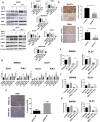Vitamin C activates pyruvate dehydrogenase (PDH) targeting the mitochondrial tricarboxylic acid (TCA) cycle in hypoxic KRAS mutant colon cancer
- PMID: 33664850
- PMCID: PMC7914362
- DOI: 10.7150/thno.51265
Vitamin C activates pyruvate dehydrogenase (PDH) targeting the mitochondrial tricarboxylic acid (TCA) cycle in hypoxic KRAS mutant colon cancer
Abstract
Background: In hypoxic tumors, positive feedback between oncogenic KRAS and HIF-1α involves impressive metabolic changes correlating with drug resistance and poor prognosis in colorectal cancer. Up to date, designed KRAS-targeting molecules do not show clear benefits in patient overall survival (POS) so pharmacological modulation of aberrant tricarboxylic acid (TCA) cycle in hypoxic cancer has been proposed as a metabolic vulnerability of KRAS-driven tumors. Methods: Annexin V-FITC and cell viability assays were carried out in order to verify vitamin C citotoxicity in KRAS mutant SW480 and DLD1 as well as in Immortalized Human Colonic Epithelial Cells (HCEC). HIF1a expression and activity were determined by western blot and functional analysis assays. HIF1a direct targets GLUT1 and PDK1 expression was checked using western blot and qRT-PCR. Inmunohistochemical assays were perfomed in tumors derived from murine xenografts in order to validate previous observations in vivo. Vitamin C dependent PDH expression and activity modulation were detected by western blot and colorimetric activity assays. Acetyl-Coa levels and citrate synthase activity were assessed using colorimetric/fluorometric activity assays. Mitochondrial membrane potential (Δψ) and cell ATP levels were assayed using fluorometric and luminescent test. Results: PDK-1 in KRAS mutant CRC cells and murine xenografts was downregulated using pharmacological doses of vitamin C through the proline hydroxylation (Pro402) of the Hypoxia inducible factor-1(HIF-1)α, correlating with decreased expression of the glucose transporter 1 (GLUT-1) in both models. Vitamin C induced remarkable ATP depletion, rapid mitochondrial Δψ dissipation and diminished pyruvate dehydrogenase E1-α phosphorylation at Serine 293, then boosting PDH and citrate synthase activity. Conclusion: We report a striking and previously non reported role of vitamin C in the regulation of the pyruvate dehydrogenase (PDH) activity, then modulating the TCA cycle and mitochondrial metabolism in KRAS mutant colon cancer. Potential impact of vitamin C in the clinical management of anti-EGFR chemoresistant colorectal neoplasias should be further considered.
Keywords: KRAS; PDK-1; cancer; chemoresistance; hypoxia; metabolism; vitamin C.
© The author(s).
Conflict of interest statement
Competing Interests: The authors have declared that no competing interest exists.
Figures




Similar articles
-
Vitamin C uncouples the Warburg metabolic switch in KRAS mutant colon cancer.Oncotarget. 2016 Jul 26;7(30):47954-47965. doi: 10.18632/oncotarget.10087. Oncotarget. 2016. PMID: 27323830 Free PMC article.
-
Mitochondria-Translocated PGK1 Functions as a Protein Kinase to Coordinate Glycolysis and the TCA Cycle in Tumorigenesis.Mol Cell. 2016 Mar 3;61(5):705-719. doi: 10.1016/j.molcel.2016.02.009. Mol Cell. 2016. PMID: 26942675 Free PMC article.
-
Oncogenic KRAS modulates mitochondrial metabolism in human colon cancer cells by inducing HIF-1α and HIF-2α target genes.Mol Cancer. 2010 Nov 13;9:293. doi: 10.1186/1476-4598-9-293. Mol Cancer. 2010. PMID: 21073737 Free PMC article.
-
Enzymes involved in l-lactate metabolism in humans.Mitochondrion. 2013 Nov;13(6):615-29. doi: 10.1016/j.mito.2013.08.011. Epub 2013 Sep 9. Mitochondrion. 2013. PMID: 24029012 Review.
-
Targeting pyruvate dehydrogenase kinase signaling in the development of effective cancer therapy.Biochim Biophys Acta Rev Cancer. 2021 Aug;1876(1):188568. doi: 10.1016/j.bbcan.2021.188568. Epub 2021 May 21. Biochim Biophys Acta Rev Cancer. 2021. PMID: 34023419 Review.
Cited by
-
Vitamin C intake and colorectal cancer survival according to KRAS and BRAF mutation: a prospective study in two US cohorts.Br J Cancer. 2023 Nov;129(11):1793-1800. doi: 10.1038/s41416-023-02452-2. Epub 2023 Sep 30. Br J Cancer. 2023. PMID: 37775523 Free PMC article.
-
Ras Family of Small GTPases in CRC: New Perspectives for Overcoming Drug Resistance.Cancers (Basel). 2021 Jul 26;13(15):3757. doi: 10.3390/cancers13153757. Cancers (Basel). 2021. PMID: 34359657 Free PMC article. Review.
-
ING5 inhibits aerobic glycolysis of lung cancer cells by promoting TIE1-mediated phosphorylation of pyruvate dehydrogenase kinase 1 at Y163.Front Med. 2024 Oct;18(5):878-895. doi: 10.1007/s11684-024-1057-7. Epub 2024 Sep 13. Front Med. 2024. PMID: 39269568
-
Assessing the Therapeutic Impacts of HAMLET and FOLFOX on BRAF-Mutated Colorectal Cancer: A Study of Cancer Cell Survival and Mitochondrial Dynamics In Vitro and Ex Vivo.Medicina (Kaunas). 2024 Jan 12;60(1):142. doi: 10.3390/medicina60010142. Medicina (Kaunas). 2024. PMID: 38256402 Free PMC article.
-
Vitamin-C-dependent downregulation of the citrate metabolism pathway potentiates pancreatic ductal adenocarcinoma growth arrest.Mol Oncol. 2024 Sep;18(9):2212-2233. doi: 10.1002/1878-0261.13616. Epub 2024 Feb 29. Mol Oncol. 2024. PMID: 38425123 Free PMC article.
References
-
- Sajnani K, Islam F, Smith RA, Gopalan V, Lam AK. Genetic alterations in Krebs cycle and its impact on cancer pathogenesis. Biochimie. 2017;135:164–72. - PubMed
-
- Sradhanjali S, Reddy MM. Inhibition of Pyruvate dehydrogenase Kinase as a Therapeutic Strategy against Cancer. Curr Top Med Chem. 2018;18:444–53. - PubMed
Publication types
MeSH terms
Substances
LinkOut - more resources
Full Text Sources
Other Literature Sources
Medical
Research Materials
Miscellaneous

